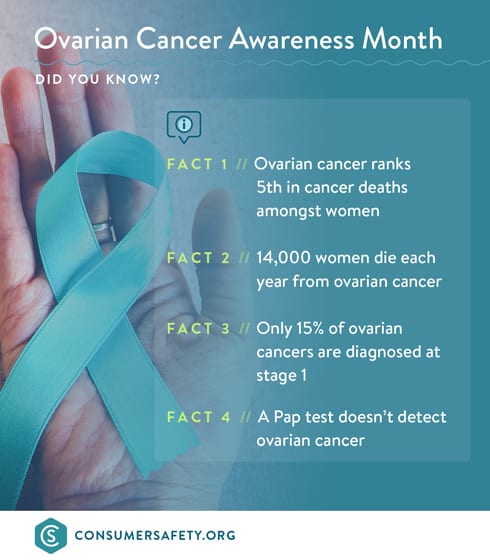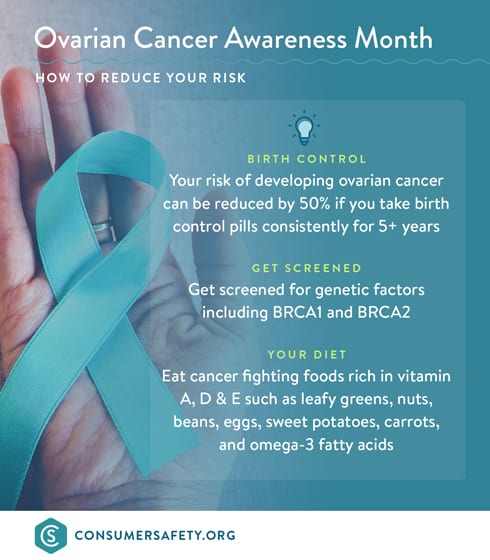Life-Saving Information: What You Need To Know About Ovarian Cancer
Every 23 minutes, a woman is diagnosed with ovarian cancer. On top of that, these women were probably diagnosed at later stages due to the symptoms being similar to typical womanly ailments. According to the Ovarian Cancer Research Fund Alliance (OCRFA), only 15% of women diagnosed with ovarian cancer is caught at stage one. Yikes.
If you’re not familiar with ovarian cancer, it’s cancer that begins in the ovaries. Each ovary (every woman has two) is about the size of an almond, and they sit on each side of your uterus in the pelvic area. These tiny organs are essential when it comes to reproduction, as they produce the eggs which then travel to the uterus where the fetus is developed. So ultimately, your ovaries need to be in tip-top shape if you want to have a healthy pregnancy.

Three types of tumors can occur. The most typical of the tumors are epithelial tumors. These tumors form in layers outside of the ovaries and account for 90% of ovarian cancer diagnoses. Another type of ovarian cancer tumors is stromal tumors, which develop in the hormone-producing cells. And lastly, there are germ cell tumors, which are found in egg-producing cells. Germ cell tumors are rare, they make up less than seven percent of ovarian cancer diagnoses and are found amongst younger women.
Seeing as September marks Ovarian Cancer Awareness Month here in the United States, it’s important to know some life-saving facts so we can help save lives together!
What are the signs?
Much like the symptoms you would associate with your period or grow older, you know, cramping, bloating, fatigue — these common symptoms are a few symptoms of ovarian cancer as well. And they’re easy to ignore. No wonder they call it a “silent killer.” Thankfully there is enough research out there to inform us on what symptoms not to ignore, especially if you’re experiencing the symptoms when you’re not supposed to have your period or if you’ve been through menopause already.
Common symptoms not to ignore:
- Abdominal bloating
- Pelvic or abdominal pain
- Trouble eating or feeling full quickly
- Feeling the need to urinate urgently or often
- Fatigue
- Upset stomach
- Back pain
- Pain during sex
- Constipation or menstrual changes
It’s important to get screened for ovarian cancer if you’re experiencing any of these symptoms. Because these symptoms can occur for many other reasons, pay attention to the persistence of them and don’t ignore them if you’re feeling off. If the cancer is caught in its earlier stages; the five-year survival rate can be up to over 90%. And if the symptoms go untreated, cancer can spread like rapid fire throughout the rest of your body, causing further damage.
Who’s at risk?
The thing about cancer is that it can happen to anyone. It’s rare to find someone who hasn’t been affected by this life-altering illness, whether it’s an immediate family member, friend or, of course, themselves. The National Cancer Institute states that almost 40% of men and women will be diagnosed with cancer in their lifetime. When speaking on ovarian cancer specifically, a woman’s risk of being diagnosed in her lifetime is one in 75. That equals to about 22,000 diagnosed each year and 14,000 deaths. How alarming is that?

Although ovarian cancer is more common amongst women in their post-menopausal stages, it can still put a damper on millennials. Knowing your family history, especially a history of breast and ovarian cancer, is crucial when it comes to your chances of being diagnosed. More specifically, having a BRCA1 or BRCA2 gene mutation puts you at a higher risk of developing ovarian cancer. Same goes for obesity. If your BMI is at least 30, your risk only increases.
Because almost all women are prone to this “silent killer,” some lifestyle changes could lower your risk. Are you a frequent user of baby powder? A recent verdict in California awarded a woman with $417 million after claiming she developed ovarian cancer from using Johnson & Johnson’s baby powder near her genitals for decades.
This is one of the thousands of lawsuits women have filed against J&J. Now you don’t have to toss all of your baby powder products; there are plenty of talc-free options out there to keep you safe — you just have to check the ingredient label! Other tips to reduce your risk of ovarian cancer is to eat foods rich in vitamin A, D, and E, as well as omega-3 fatty acids. And if you have been using oral contraceptives for over five years, it can reduce your risk by 50%!
What to do next?
Now that you know the facts and relevant statistics, what should you do next? First things first, get screened! It’s the easiest way to detect if you’re developing ovarian cancer, especially if you’re experiencing any changes to the body. Your yearly Pap smear only screens for cervical cancer so it’s important to alert your doctor of these symptoms, even if you think it might not be a big deal.
You should also inform your friends and family. Knowledge is power and the more women AND men who know about the signs of ovarian cancer, the better! We truly can help save lives by passing along the information we absorb.
Let’s all work together to help spread the word about common symptoms and ways we can reduce the risk of ovarian cancer for women all over the world. Please feel free to share this vital information with your friends and loved ones! And don’t forget to talk to your doctor if you have any questions or concerns about ovarian cancer.






